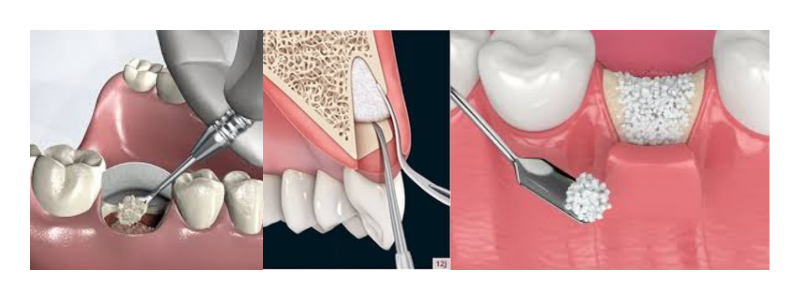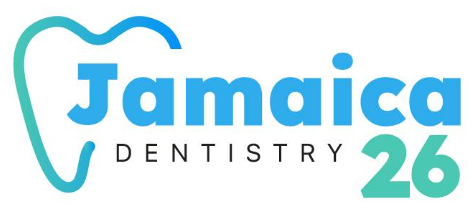Socket Preservation

A socket is an empty space within the jawbone when a tooth has been extracted. It may appear as a natural effect of the removal of teeth, but the next thing that follows may have a serious impact on the health of your oral environment. With the loss of the support of the tooth root, the bone around the tooth can start to recede and be lost, a process known as bone resorption.
This can lead to changes in jawbone structure, shifting of nearby teeth, and complications with future dental treatments like implants or bridges. Socket preservation is a preventative procedure that occurs immediately after an extraction to maintain the structure, strength and shape of the jawbone. Dentists can use a piece of bone graft directly into the socket to seal it off and allow adequate healing to occur to preserve your long-term oral rehabilitation ability.
At Jamaica 26 Dentistry (the area behind the podium) we also manage socket preservation procedures so that your smile remains healthy and sturdy in order to have subsequent restorations.
What is Socket Preservation?
Socket preservation is a dental procedure designed to preserve the structure of both the bone and tissue following tooth extraction. Once a tooth is removed, the adjacent bone and gum tissue will automatically start to reshape as an outcome of the recovery. This natural change, however, usually leads to loss of the bone, which increases the risks to the integrity of surrounding teeth and brings problems with future dental restorations.
Socket preservation involves inserting a grafting material (usually synthetic bone, donor bone, or the patient own bone) into the socket shortly after having the tooth extracted.This substance serves as a scaffold and persuades the body to redevelop bone in that region and maintain the normal curves of the jawline and gum tissue. It is a non-invasive procedure that usually goes hand-in-hand with the extraction, on the same day.
Instead of allowing the bone to degrade over time, socket preservation can serve to provide a healthy base on which to build subsequent procedures, such as implants or bridges. It is an essential procedure in modern dentistry that involves the combination of functionality, esthetics and long-term strategies that help preserve your oral health.
We provide cost-effective and efficient socket preservation therapies that can assist you in preserving a robust and healthy smile at Jamaica 26 Dentistry.
Types of Grafting Materials Used
Socket preservation is done using bone grafting materials that promote the regeneration of new bones and can be used to maintain the integrity of a jaw in case of the removal of teeth. Graft materials are also of several types with distinct advantages. Depending on your oral health, treatment plan, and preferences, your dentist will choose the suitable material type.
Autografts (Your Own Bone)
Autografts use your own bone, taken out of one part of your body, usually the jaw, chin or hip. As the graft tissue is your own, it matches your tissue perfectly and often yields very high success rates. It requires a second surgery site and that may involve more recovery time.
Allografts (Human Donor Bone)
Allografts are processed human bone materials obtained from donors, normally acquired via controlled tissue gifting banks. They are well screened, safe, and are commonly used in dental procedures. The second surgical site is unnecessary for these grafts, and most patients have a convenient and effective alternative.
Xenografts (Animal-Derived Bone)
The xenografts are typically of bovine (cow) bone and occasionally of porcine (pig) bone. These grafts are sterilized and subsequently processed to meet sterilization requirements and are tested to determine their biocompatibility. Xenografts offer a robust framework in which new bone growth may occur and are commonly employed when longer-term support and slow resorption is needed.
Alloplasts (Synthetic Materials)
Alloplasts are artificial grafts that replicate bone. They can be made out of biocompatible materials such as calcium phosphate or hydroxy apatite and are readily accepted by the body, and provide a high quality alternative for those patients who do not wish to use animal or human tissue. These materials are slowly taken in by the bone and facilitate regeneration.
All the grafting alternatives fulfill a particular purpose and can be selected based on your medical background, quality of the bones, personal preferences, and goals for the long term of your dental health.
When is Socket Preservation Needed for Patients?
After a Tooth Extraction
In teeth where the bone and gum structure are essential both functionally as well as cosmetically, as in molars or front teeth.
If You are Planning for a Dental Implant
Socket preservation ensures sufficient bone volume and density to sustain an implant in place.
When the Jawbone is Thin or Fragile
Socket preservation is used to protect patients with naturally thin bones or those who have early signs of bone loss to ensure further damage is prevented.
To Maintain Facial Structure
Leaving the socket intact maintains a facial appearance by avoiding the sunken effect that arises when bone degenerates over time
To Support Surrounding Teeth
Prevents shifting or misalignment of neighboring teeth by keeping the jawbone stable and intact.
In Cases of Gum Recession Risk
Supports natural levels of gums and prevents excessive loss of tissue in high-risk areas.
For Better Aesthetic Results
Socket preservation, especially where the smile is visible, prevents loss of natural contour to give a more appealing result than would be the case with any future restoration.
What Happens During Socket Preservation?
Preservation of a socket is often a short procedure where a socket is preserved after a tooth has been removed in a very minimally invasive process. It is meant to safeguard the extraction area and stimulate healthy bone growth. The following is a chronological guide to what you may experience:
Tooth Extraction
It starts with the extraction of the affected or rotten tooth carefully. Your dentist will make the extraction as smooth and sterile as possible to prevent damaging the surrounding bone and tissue.
Placement of Bone Graft Material
After removing the tooth, the socket is filled with a bone grafting material. The graft may be from many different sources such as synthetic sources, donor bone, animal bone grafts or your bone. It serves as a scaffold to facilitate the growth of new bone and it retains the shape of the socket.
Use of Collagen Membrane (If Applicable)
A protective collagen membrane over the graft is used in many cases. This membrane helps in covering the grafted region, proper tissue regeneration and prevents the growth of soft tissue in the bone space as it heals.
Stitches or Natural Healing
Your dentist may then seal the site with the stitches that dissolve depending on the case to ensure that the graphics remain intact and healing occurs. In different cases, the area can be left to repair itself on its own after the membrane is applied.
Duration of the Procedure
The overall process of socket preservation typically lasts 30 to 60 minutes depending on the level of difficulty of the extraction and the number of teeth set to be removed. It is usually done within one sitting immediately after the removal.
Healing and Aftercare
Socket preservation requires proper healing and aftercare in order to be effective. Paying close attention to the instructions given by your dentist and subsequently attending follow-ups can help your bones regenerate in the best possible way and manage any complications.
Recovery Timeline
The first stage of healing is usually within 1-2 weeks when the gum tissue covers the grafted position. But depending on the kind of graft and your body’s healing capacity, bone regeneration may take 3 to 6 months. Within this period, the graft will fuse with your jawbone and form a solid base on which your future dental restorations will be supported.
Post-Operative Care Instructions
These are some general aftercare tips to help heal and avoid complications:
- Do not touch the place with your tongue, fingers or food.
- In the first 24 hours, do not rinse or spit hard.
- Cold compresses should be utilized in the first 48 hours to help with the swelling.
- Use pain medications to address pain and avoid infection, following the directions provided.
- During the first several days, eat soft food products and avoid hot or spicy, as well as crunchy food.
- Smoking and tobacco use should be avoided because it may affect the healing process and predispose towards graft failure.
- Practice good oral health care, but be careful near the after surgery location when brushing and flossing.
When to Contact Your Dentist
Mild discomfort, swelling, or slight bleeding is expected. You must call your dentist in the case of:
- Severe pain that does not respond to medication
- Severe or chronic bleeding
- Symptoms of infection like fever, bad smell or pus
- Detached or non-firm graft tissue
Benefits of Socket Preservation
The benefits for socket preservation are given below:
- It prevents the loss of natural bone structure and volume when teeth are extracted.
- Improves aesthetic appearance by maintaining the shape of jaw and gums to rebuild later.
- Minimizes the future necessity of more invasive bone grafting surgical procedures.
- Enhances the effectiveness and stability of placing dental implants or bridges within the area.
- Helps to avoid the movement or malposition of nearest teeth.
- Contributes to general dental health by preserving jaw bones.
FAQs
Is socket preservation necessary after every tooth extraction?
Not necessarily, but when there are plans to have dental implants in the future or when the tooth is well seen or very useful in the mouth, then it is very advisable. The needs will be assessed based on bone densities, location, and long-term plans by your dentist.
Does socket preservation hurt?
The procedure is usually carried out under local anaesthesia and you will not experience pain during the treatment. There might be mild pain or swelling post-surgery, which is easily addressed with pain medication provided by your prescribing physician and simple aftercare.
How long does it take to heal after socket preservation?
Healing of the gums can occur within 1-2 weeks, though it will require 3-7 months of further healing before the grafted bone can fully settle in and mature, especially when you have a dental implant planned after.
Can I get a dental implant without socket preservation?
It is possible, but probably more complex. Loss of the socket can result without socket preservation and a larger bone graft may be required prior to the placement of an implant. Conservation of a socket at an early stage may make future procedures easier.
Is socket preservation covered by dental insurance?
Insurance coverage is dependent on the insurance company. Socket preservation can be included in some plans, however, when it is medically necessary, particularly when this preservation supports future restorative procedures. You should ask your dentist and insurance for details.
